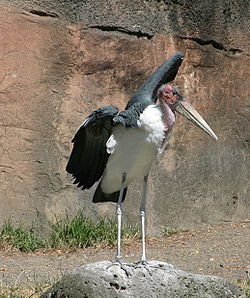Leptoptilos
| Leptoptilos Temporal range: Late Miocene to Recent
| |
|---|---|

| |
| Marabou Stork, Leptoptilos crumeniferus | |
| Scientific classification | |
| Kingdom: | |
| Phylum: | |
| Class: | |
| Order: | |
| Family: | |
| Genus: | Leptoptilos Lesson, 1831
|
| Species | |
|
L. javanicus | |
| Synonyms | |
|
Cryptociconia | |
Leptoptilos is a genus of very large tropical storks. Two species are resident breeders in southern Asia, and the Marabou Stork is found in sub-Saharan Africa.
These are huge birds, typically 110–150 cm tall with a 210–250 cm wingspan. The three species each have a black upper body and wings, and white belly and undertail. The head and neck are bare like those of a vulture. The huge bill is long and thick. Juveniles are a duller, browner version of the adult.
Leptoptilos storks are gregarious colonial breeders in wetlands, building large stick nests in trees. They feed on frogs, insects, young birds, lizards and rodents. They are frequent scavengers, and the naked head and neck are adaptations to this, as are those of the vultures with which they often feed. A feathered head would become rapidly clotted with blood and other substances when a scavenging bird's head was inside a large corpse, and the bare head is easier to keep clean.
Most storks fly with neck outstretched, but the three Leptoptilos storks retract their necks in flight like a heron.
Species
- Lesser Adjutant, Leptoptilos javanicus
- Greater Adjutant, Leptoptilos dubius
- Marabou Stork, Leptoptilos crumeniferus
There is an ample fossil record of this genus. L. titan, which was hunted by prehistoric humans, was truly gigantic, and L. falconeri possibly was one of the most widespread storks worldwide during the Pliocene:
- Leptoptilus patagonicus (Puerto Madryn Late Miocene of Valdés Peninsula, Argentina)
- Leptoptilos richae (Beglia Late Miocene of Bled ed Douarah, Tunisia, and Wadi Moghara, Egypt?)
- Leptoptilos sp. (Ngorora Late Miocene of Baringo District, Kenya: Louchart et al. 2005)
- Leptoptilos falconeri (Early to Late Pliocene of S Asia and E Africa)
- Leptoptilos pliocenicus (Early Pliocene of Odessa, Ukraine and Urugus, Ethiopia to Late Pliocene of Koro Toro, Chad and Olduvai, Tanzania) – includes L. cf. falconeri, may be the same as L. falconeri
- Leptoptilos indicus (Late Pliocene of Siwalik, India) – formerly Cryptociconia indica, may be the same as L. falconeri (Louchart et al. 2005)
- Leptoptilos titan (Notopuro Middle/Late Pleistocene of Watualang, Java)
"Leptoptilos" siwalicensis from the Siwalik deposits (Late Miocene? to Late Pliocene) may belong to this genus or to a closely related one (Louchart et al. 2005).
References
- Grimmett, Richard; Inskipp, Carol, Inskipp, Tim & Byers, Clive (1999): Birds of India, Pakistan, Nepal, Bangladesh, Bhutan, Sri Lanka, and the Maldives. Princeton University Press, Princeton, N.J.. ISBN 0-691-04910-6
- Louchart, Antoine; Vignaud, Patrick; Likius, Andossa; Brunet, Michel & and White, Tim D. (2005): A large extinct marabou stork in African Pliocene hominid sites, and a review of the fossil species of Leptoptilos. Acta Palaeontologica Polonica 50(3): 549–563. PDF fulltext
